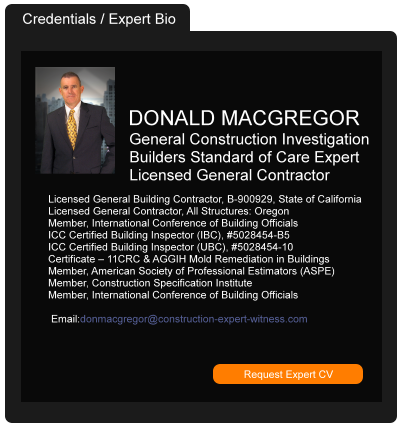Bill would expand multi-year construction and procurement authority in Georgia
March 06, 2023 —
David R. Cook Jr. - Autry, Hall & Cook, LLPA bill introduced in the General Assembly would modify the authority of state and local governments, as well as school systems, to enter multi-year contracts for construction and procurement. In many prior posts, we have addressed state and local governments’ authority to enter guaranteed energy savings performance contracts and multi-year contracts.
Read the court decisionRead the full story...Reprinted courtesy of
David R. Cook Jr., Autry, Hall & Cook, LLPMr. Cook may be contacted at
cook@ahclaw.com
KB to Spend $43.2 Million on Florida Construction Defects
August 27, 2013 —
CDJ STAFFIn their second quarter filing with the SEC, KB Homes estimates that repairing damage caused by defects in framing, stucco, roofs, and sealant will cost it $43.2 million. That estimate includes homes that are yet to be identified. KB had estimated lower costs earlier, but subsequently determined it was necessary to increase the funds by $15.9. As a result, the firm showed a loss in the second quarter. The company hopes to recover some funds in insurance settlements.
Read the court decisionRead the full story...Reprinted courtesy of
Cincinnati Team Secures Summary Judgment for Paving Company in Trip-and-Fall Case
February 05, 2024 —
Lewis BrisboisCincinnati, Ohio (January 25, 2024) - In a recent decision by the Oldham County Circuit Court, Lewis Brisbois Partner Andrew Weber and Associate Jason Paskan obtained summary judgment for a paving company client after successfully arguing that their client did not owe the plaintiff a duty at the time leading up to her trip and fall. Although the court concluded that there was a genuine issue of fact as to whether a parking space wheel stop actually caused her fall, the court noted that whether the wheel stop “constituted an unreasonably dangerous condition necessitating a duty to eliminate them or warn of them is an entirely different matter.” Rebecca Reynolds v. Baptist Healthcare System, Inc., et al., Oldham Circuit Court Case No. 21-CI-00236, *6 (Dec. 21, 2023).
The plaintiff in Reynolds drove to the hospital with her sister-in-law for medical testing. Id. at * 2. While both had been to the hospital before, due to COVID and construction in the emergency department, they had to take a different entrance into the hospital. Id. In the plaintiff’s attempt to navigate the parking lot, she allegedly tripped over a black wheel stop that was covered by a shadow. Id. The plaintiff sued the hospital as the landowner and the paving company working in the hospital’s parking lot, among others, under the theory that the failure to stripe the wheel stop, closing off spaces with the black wheel stops, or posting warnings about the condition of the parking lot would have prevented her fall. Id. at *2-3.
Read the court decisionRead the full story...Reprinted courtesy of
Lewis Brisbois
Immigrants' Legal Status Eyed Over Roles in New York Fake Injury Lawsuits
January 07, 2025 —
Richard Korman - Engineering News-RecordEdison Fernando Pesantez Ramon says that early on the morning of Sept. 29, 2021, while working on a building renovation project on 96th Street in Manhattan, he tripped and fell badly on a staircase.
Read the court decisionRead the full story...Reprinted courtesy of
Richard Korman, ENRMr. Korman may be contacted at
kormanr@enr.com
New Jersey Supreme Court Holding Impacts Allocation of Damages in Cases Involving Successive Tortfeasors
March 28, 2022 —
Thomas Regan & Karley Kamaris - Lewis BrisboisNewark, N.J. (March 21, 2022) - Late in 2021, the Supreme Court of New Jersey addressed the issue of allocating damages in personal injury cases in which the plaintiff asserts claims against successive tortfeasors, such as medical malpractice in the treatment of a slip and fall injury caused by negligence. The decision in Glassman v. Friedel, 249 N.J. 199 (2021) overruled and replaced the long-held principles established in Ciluffo v. Middlesex General Hospital, 146 N.J. Super. 478 (App. Div. 1977) regarding successive liability. Ciluffo held that, when an initial tortfeasor settles before trial, the non-settling defendants in a successive tort were entitled to a pro tanto credit for the settlement amount against any damages assessed against them. The Superior Court of New Jersey Appellate Division in 2020, and the Supreme Court of New Jersey last year, abandoned that framework for one more consistent with statutory contribution law in the Garden State.
In Glassman v. Friedel, 465 N.J. Super. 436 (App. Div. 2020), the Appellate Division held that the application of the principles in Ciluffo in a negligence case has no support in modern jurisprudence, thus limiting its application. It rejected the holding in Ciluffo in light of the state legislature’s enactment of the Comparative Negligence Act, which requires juries to apportion damages between successive events and apportion fault among the parties responsible for each event. The appellate division went on to hold that a non-settling, successive tortfeasor may present proofs at trial as to the negligence of the settling tortfeasor, and that the burden of proof as to the initial tortfeasor’s negligence being the proximate cause of the second causative event indeed lies on the non-settling defendant. In sum, the appellate division in Glassman established steps the jury can use to determine successive tortfeasor liability, but largely treated it as one, attenuated incident.
Reprinted courtesy of
Thomas Regan, Lewis Brisbois and
Karley Kamaris, Lewis Brisbois
Mr. Regan may be contacted at Thomas.Regan@lewisbrisbois.com
Ms. Kamaris may be contacted at Karley.Kamaris@lewisbrisbois.com
Read the court decisionRead the full story...Reprinted courtesy of
Corporate Transparency Act’s Impact on Real Estate: Reporting Companies, Exemptions and Beneficial Ownership Reporting (webinar)
December 04, 2023 —
Pillsbury's Construction & Real Estate Law Team - Gravel2Gavel Construction & Real Estate Law BlogOn October 23, 2023, colleague
Andrew Weiner and Kevin Gaunt, counsel at Hunton Andrews Kurth, examined the Corporate Transparency Act (CTA), effective Jan. 1, 2024, and its impact on real estate entities and transactions, including who is considered a reporting company subject to new beneficial ownership information (BOI) reporting requirements and whether an exemption applies. The panel also discussed certain state laws that impose similar reporting requirements as the CTA and described best practices for real estate counsel to assist their clients with preparing for the CTA’s implementation and ongoing compliance.
The panel also reviewed other important considerations, including:
- Which real estate entities will likely be most affected by the CTA’s implementation and why?
- What exemptions may apply?
- How will the CTA’s reporting requirements affect real estate transactions for lenders and investors/buyers?
Read the court decision
Read the full story...
Reprinted courtesy of Pillsbury's Construction & Real Estate Law Team
California Courts Call a “Time Out” During COVID-19 –New Emergency Court Rules on Civil Litigation
May 04, 2020 — Tara C. Dudum - Newmeyer Dillion
“We are at this point truly with no guidance in history, law, or precedent. To say that there is no playbook is a gross understatement of the situation.”
-Chief Justice and Chair of the California Judicial Council, Tani G. Cantil-Sakauye
Seeking to sustain essential court services while balancing weighty considerations, including litigants’ due process rights, access to justice, and stringent health and safety orders, the California Judicial Council has adopted Emergency Rules in response to the ongoing coronavirus pandemic (COVID-19).
While many of the Emergency Rules focus on criminal and juvenile dependency matters, this update highlights the Emergency Rules immediately impacting civil litigation in California state courts. The following Emergency Rules remain in effect until 90 days after the Governor lifts the state of emergency or the rule is amended or repealed by the Judicial Council:
Tolling of Statutes of Limitation in Civil Actions
Effective April 6, 2020, the statutes of limitation (the time period in which to bring a claim) for all civil causes of action is tolled until such time as the rule is no longer in effect. The impact of this rule is that it provides plaintiffs with more time to bring claims and extends the time period that defendants may face legal action for alleged violations of the law. Read the court decision
Read the full story...
Reprinted courtesy of Tara C. Dudum, Newmeyer Dillion
Ms. Dudum may be contacted at tara.dudum@ndlf.com
If I Released My California Mechanics Lien, Can I File a New Mechanics Lien on the Same Project? Will the New Mechanics Lien be Enforceable?
December 29, 2020 — William L. Porter - Porter Law Group
If I Released My California Mechanics Lien, Can I File a New Mechanics Lien on the Same Project? Will the New Mechanics Lien be Enforceable?
In general, the answer to the above questions is “Yes”, but only if you meet the following requirements:
- You must only release the mechanics lien itself, but not the “right” to a mechanics lien: There is an important distinction to be made between releasing a mechanics lien and releasing the right to a mechanics lien. Whether you do one or the other will depend on the specific language used in your release. In the case of Santa Clara Land Title Co. v. Nowack and Associates, Inc. (1991) 226 Cal. App.3d, 1558 a “release of mechanics lien” document was recorded TO THE County Recorder’s office which included a statement that the mechanics lien was “fully satisfied, released and discharged”. Based on this language, the court concluded that the mechanics lien claimant had waived its “right” to a further mechanics lien on the same property for the work in question. The court concluded that since the release stated that the claim was “fully satisfied” the right to mechanics lien on the project had forever been waived. The Nowak case can be distinguished from the case of Koudmani v. Ogle Enterprises, Inc., (1996) 47 Cal.App.4th 1650, where the release of mechanics lien only stated that the mechanics lien was “otherwise released and discharged” and not that it was “satisfied”. Based on the distinction drawn from the two cases, a simple mechanics lien release that only releases the mechanics lien itself, but not the “right” to a mechanics lien should be used. At the following link you will find a proper form to achieve this purpose: https://www.porterlaw.com/wp-content/uploads/2019/06/03PRI-Mechanics-Lien-Release.pdf
Read the court decision
Read the full story...
Reprinted courtesy of William L. Porter, Porter Law Group
Mr. Porter may be contacted at bporter@porterlaw.com


































































